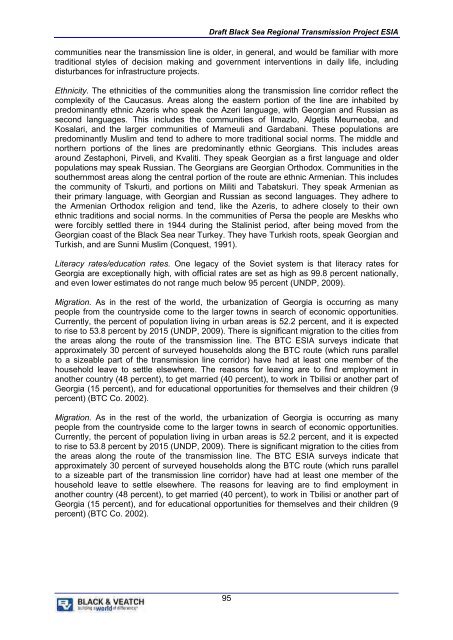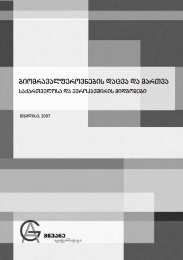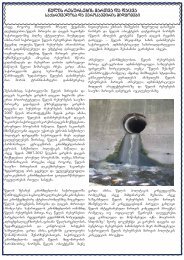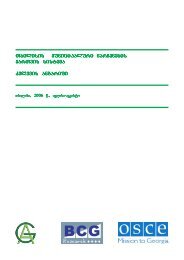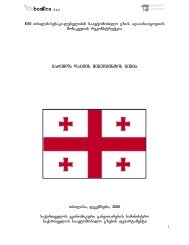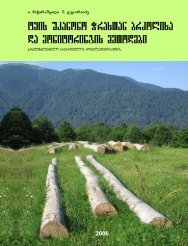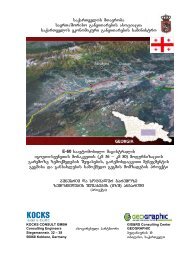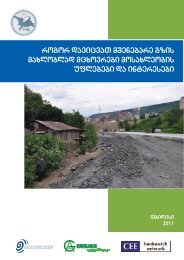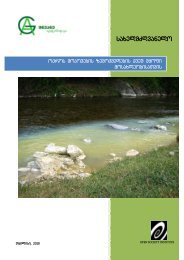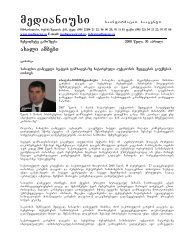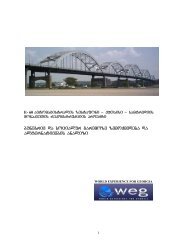Part I
Part I
Part I
You also want an ePaper? Increase the reach of your titles
YUMPU automatically turns print PDFs into web optimized ePapers that Google loves.
Draft Black Sea Regional Transmission Project ESIA<br />
communities near the transmission line is older, in general, and would be familiar with more<br />
traditional styles of decision making and government interventions in daily life, including<br />
disturbances for infrastructure projects.<br />
Ethnicity. The ethnicities of the communities along the transmission line corridor reflect the<br />
complexity of the Caucasus. Areas along the eastern portion of the line are inhabited by<br />
predominantly ethnic Azeris who speak the Azeri language, with Georgian and Russian as<br />
second languages. This includes the communities of Ilmazlo, Algetis Meurneoba, and<br />
Kosalari, and the larger communities of Marneuli and Gardabani. These populations are<br />
predominantly Muslim and tend to adhere to more traditional social norms. The middle and<br />
northern portions of the lines are predominantly ethnic Georgians. This includes areas<br />
around Zestaphoni, Pirveli, and Kvaliti. They speak Georgian as a first language and older<br />
populations may speak Russian. The Georgians are Georgian Orthodox. Communities in the<br />
southernmost areas along the central portion of the route are ethnic Armenian. This includes<br />
the community of Tskurti, and portions on Militi and Tabatskuri. They speak Armenian as<br />
their primary language, with Georgian and Russian as second languages. They adhere to<br />
the Armenian Orthodox religion and tend, like the Azeris, to adhere closely to their own<br />
ethnic traditions and social norms. In the communities of Persa the people are Meskhs who<br />
were forcibly settled there in 1944 during the Stalinist period, after being moved from the<br />
Georgian coast of the Black Sea near Turkey. They have Turkish roots, speak Georgian and<br />
Turkish, and are Sunni Muslim (Conquest, 1991).<br />
Literacy rates/education rates. One legacy of the Soviet system is that literacy rates for<br />
Georgia are exceptionally high, with official rates are set as high as 99.8 percent nationally,<br />
and even lower estimates do not range much below 95 percent (UNDP, 2009).<br />
Migration. As in the rest of the world, the urbanization of Georgia is occurring as many<br />
people from the countryside come to the larger towns in search of economic opportunities.<br />
Currently, the percent of population living in urban areas is 52.2 percent, and it is expected<br />
to rise to 53.8 percent by 2015 (UNDP, 2009). There is significant migration to the cities from<br />
the areas along the route of the transmission line. The BTC ESIA surveys indicate that<br />
approximately 30 percent of surveyed households along the BTC route (which runs parallel<br />
to a sizeable part of the transmission line corridor) have had at least one member of the<br />
household leave to settle elsewhere. The reasons for leaving are to find employment in<br />
another country (48 percent), to get married (40 percent), to work in Tbilisi or another part of<br />
Georgia (15 percent), and for educational opportunities for themselves and their children (9<br />
percent) (BTC Co. 2002).<br />
Migration. As in the rest of the world, the urbanization of Georgia is occurring as many<br />
people from the countryside come to the larger towns in search of economic opportunities.<br />
Currently, the percent of population living in urban areas is 52.2 percent, and it is expected<br />
to rise to 53.8 percent by 2015 (UNDP, 2009). There is significant migration to the cities from<br />
the areas along the route of the transmission line. The BTC ESIA surveys indicate that<br />
approximately 30 percent of surveyed households along the BTC route (which runs parallel<br />
to a sizeable part of the transmission line corridor) have had at least one member of the<br />
household leave to settle elsewhere. The reasons for leaving are to find employment in<br />
another country (48 percent), to get married (40 percent), to work in Tbilisi or another part of<br />
Georgia (15 percent), and for educational opportunities for themselves and their children (9<br />
percent) (BTC Co. 2002).<br />
95


